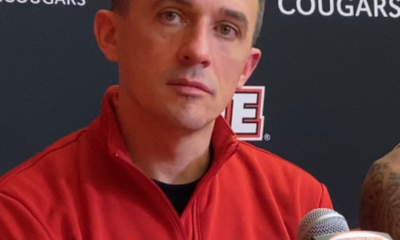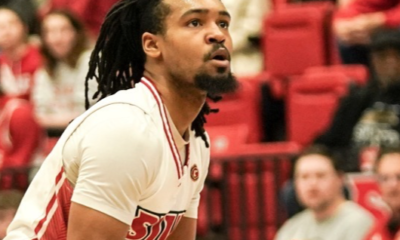Ohio Valley
OVC – A League on the Rise
The New Look OVC
(St. Louis, MO) – Is the new look Ohio Valley Conference a league on the rise? The OVC placed two teams in the NCAA Tournament, won some games during March Madness and will have a top ten pick in this summer’s NBA draft.
Over the past two years there has been massive turnover in the OVC’s coaching ranks, so the question remains, is the league on the rise, or just in transition? The retirement of Rick Byrd begs the question about Belmont’s sustained excellence. Matt McMahon staying put at Murray State heartens OVC fans that the Racers will continue to soar.
Six of twelve programs have coaches that have been on the job less than three years. Eastern Illinois’ Jay Spoonhour (eight years) is now the ‘dean of OVC coaches’. Two coaches just finished their first years in the league. Brian ‘Penny’ Collins (Tennessee State), A.W. Hamilton (Eastern Kentucky) and there will be three first timers this season.
Casey Alexander takes over for Byrd at Belmont while Brian Barone steps in at Southern Illinois Edwardsville and John Pelphrey begins at Tennessee Tech. Matt Figger’s two full seasons at Austin Peay make him a virtual veteran in the league. Only Rick Ray (Southeast Missouri) and Spoonhour have been at their present positions more than five years.
The League Is Improving
The OVC’s national metrics are improving. According to realtimerpi.com the league has improved the past two seasons. A national ranking as the 25th best league in 2017, the OVC was 21st two seasons ago and 20th in 2018-19.
For the first time since 1987 the league placed two teams in the NCAA Tournament. It was also the first time since 1971, that the conference won two March Madness games. Receiving four units of the NCAA Tournament dividends instead of one, will be significant to each OVC team’s budget.
Attendance figures can be fickle and manipulated, but attendance has slightly improved too. OVC teams averaged 2,070 fans per home game in 2016-17, 1,973 during the 2017-18 season and 2,166 last year.
Speaking of attendance, the OVC Tournament was wildly successful. Twice, Evansville, Indiana’s Ford Center was the venue for record setting attendance numbers. The semifinal crowd of 8,294 broke the tournament’s all-time attendance record. That record was shattered the next night as 10,525 witnessed the Murray State/Belmont championship game.
Murray State dwarfed the rest of the league by drawing 5,442 fans per game. No other team drew more than 2,700 per contest. Six of the league members averaged less than 2,000 fans per game.
Awards & Accomplishments
Ja Morant took home more awards than Michael Phelps and Dylan Windler wasn’t far behind. Morant has been rumored as a top five pick in the upcoming draft (some say top 2) and Windler is also likely to be drafted.
Three OVC teams ranked in the top 21 in road wins and four conference teams amassed at least 20 wins.
Belmont led the nation in assists and assist-turnover ratio and was second nationally in scoring. Murray State was third the 3-point defense and Eastern Kentucky was second in steals. Of course Morant led the country in assists and in triple-doubles, while Windler was tenth in rebounding and EKU’s Nick Mayo was tenth in scoring.
The OVC made some national noise.
Improving Talent
It will be hard to improve the talent level during this year’s OVC season. Losing Morant, Windler, Mayo and other high-level seniors will be hard to replace. However there are stars in the making and recruiting levels have been improving in recent seasons.
Austin Peay’s Terry Taylor returns for his junior season. 2018’s Freshman of the Year, is a two-time all-OVC performer. Belmont’s trio of sophomores, Nick Muszynski, Grayson Murphy and Caleb Hollander seem poised to take up the Bruin banner of excellence.
Murray State’s Tevin Brown could be Murray State’s next emerging star guard and Jacksonville State’s collection of free-agents are stellar.
The overall talent of the league is improving. The average 2017 score for an OVC recruiting class was 2.098 stars per player. The past two years that average has elevated to 2.135. There are some highly regarded players coming to the OVC this season.
UT Martin’s Parker Stewart was a four-star player coming out of high school and signed with Pittsburgh. During his one season in the Panther uniform, the 6’5 guard averaged 9.1 points per game and converted .425 of his three-point attempts. After his freshman season he decided to transfer and play with his father, UTM’s head coach Anthony Stewart. The younger Stewart will likely be an all-conference type player.
Austin Peay has signed two of the best prep players in Texas. Eastern Kentucky has added UNC Wilmington transfer Tyrone Taylor and we believe former three-star, North Carolina transfer Darius Hicks will be eligible to play. JSU has added two, top 100 juco players in Martin Roub and Keiodre Perry. Three star players Noah Kamba (Murray State) and Mark Freeman (Tennessee State) are coming into the league.
(Star rankings based on data from verbalcommits.com)
Are They Making the Financial Investment?
Predictably the programs spending the most money are winning the most games. According to Mark Adams (Twitter @Enthusiadams) and his ‘doing more with less’ statistics, Belmont, Murray State and Austin Peay are the top three spenders. Jacksonville State is fifth.
Belmont ($3,194,309) far outspends everyone else. Murray State at $2.123,603 is second. Austin Peay’s $1,906,154 is third, while Eastern Kentucky and JSU both spend roughly $1.5 million. Last season the Bruins and Racers tied for first, the Gamecocks were third and the Governors finished fourth in the standings. On average, OVC universities spent $1.48 million on their basketball programs.
(all budget numbers come from Mark Adams as per US Department of Education and reflect spending during the 2017-18 fiscal year)
It seems apparent that teams must spend money to succeed.
The Intangibles
Clearly the league data points prove it is a league on the rise. The OVC Tournament has gone from an afterthought to ‘must see basketball’. From Austin Peay’s improbable run of 2016 to the last two seasons in Evansville, it has become a ‘show-stopper’.
The additions of Figger at APSU and Ray Harper at JSU have pushed those teams into the weekly conversations concerning who can tackle Belmont and Murray State. Belmont losing Byrd to retirement was huge, but Casey Alexander is a proven commodity and the Bruins will be just fine. When last place Tennessee Tech landed former Arkansas head coach Pelfrey, that was a signal that the Golden Eagles will improve.
Eastern Kentucky is a team on the rise and so is UT Martin. In A.W. Hamilton’s first EKU season, the Colonels only improved their win total by two (13 from 11), but their attendance jumped nearly 800 fans per game. EKU’s high-octane offense and pressure defense entertained the fans.
Transition
OVC history points to transition and turnover. League members hit the transfer wire and junior college circuit hard. Coaches seem to come and go and teams climb high in the standings only to tumble back down again. Only Belmont and Murray State have been able to sustain success. Now Austin Peay and Jacksonville State seem to be on their plain.
If a fifth or sixth team can join that upper echelon, this could truly be a league on the rise.
Do Good













